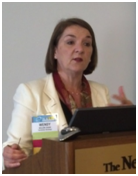By Any Other Name
It has become increasingly clear to me that there is a growing resistance to diversity and inclusion initiatives in the workplace as incidents of blatant racism, sexism and really all ‘isms’ seem to be on the rise. I cannot definitively assert that there is a direct correlation between these two trends, but I believe that there is. So, I have developed a concept called “Stealth Inclusion.” Stealth Inclusion is a way to create inclusion in organizations by helping executives who may not necessarily acknowledge that they need help, to solve organizational problems. This is particularly necessary where ‘exclusive’ cultures result in negative conditions, such as: employee turnover, disengagement, sabotage, diminished market share, poor or damaged public image, etc.
In Act II, Scene II of “Romeo and Juliet,” Juliet says the following to Romeo, in response to his concerns over their belonging to feuding families:
“What’s in a name? that which we call a rose 
By any other name would smell as sweet;”
So, what if we don’t call diversity and inclusion initiatives by their name, but use other names? What if we call our strategies, strategies for success, instead of inclusion strategies and our assessments, corporate assessments, instead of cultural assessments? What if we use different or diverse words to describe what it is that we do and why it is that we do it?
By Any Means Necessary
In 1963 Jean-Paul Sartre wrote the words “by any means necessary” regarding class struggle, in his play Dirty Hands. The phrase was made famous by Malcolm X a year later and became a metaphor for justifying violence to overcome oppression. (Which I certainly am not advocating!) What I am encouraging is that we find different ways to accomplish our missions. Is your organization behaving in a healthy way? (See my 2007 article, “The Evolution of Inclusion,” where I discuss organizations as organisms (Posted in my blog in January 2014)). Do the members of your organization:
a.) Know what your organizational mission is?
b.) Feel invited to contribute to the success of that mission?
If people are being excluded at your organization because of where or when they were born, how they worship, what they look like, how they identify, or any other distinction, you have a problem that needs a solution – a real, sustainable solution. You do not need buzz words, or pot luck luncheons, or awards programs – you need effective strategies that can help you to cross the complex chasms that separate you from achieving your goals and getting that mission accomplished!
What motivates the people around you? What really gets people excited enough to jump out of bed when it is still dark out and stay at the office past sunset? Being part of a mission matters to you and to everyone else! Being INCLUDED is what excites all of us! Being invited to help, create, innovate, achieve, and win! Not everyone can invite themselves to the party, many people need to be asked, many people come from places where there are different rules and customs about participation.
Excellent leaders learn about those different customs and learn how to invite and organize participation. Even when people have a common mission and are as motivated as the people were who filled Tahrir Square in Cairo in 2011, an effective, sustainable strategy must be implemented in order for success to occur. That requires experienced and competent leadership: leaders who are flexible and open to learning and finding new ways to achieve their goals when old ways fail. So, if we do not call it ‘Diversity Training’, but ‘Effective Communication’ and ‘Successful Leadership, does it really matter? [Note: This does not mean that I am changing the name of the company!] The most effective leaders know what they don’t know and bring in subject matter experts to provide the knowledge and competencies that they lack. Hence, part of a great strategy is having the right team members.
Mission Accomplished!
What is your goal? What is your personal mission? I have shared mine with you before: To make manifest the value of all people. Sounds simple, no? Well, it is not simple, it is complicated and takes real knowledge and competency and care and skill and passion and yes, sometimes, it takes Stealth Inclusion!
If you are not overcoming the barriers to inclusion at your organization, isn’t it about time that you do?
Onward!
~ Wendy
Please let me know what you think in the comment section below or email me: wendy@inclusionstrategy.com
Please follow us on Twitter for more frequent observations and information. 





















